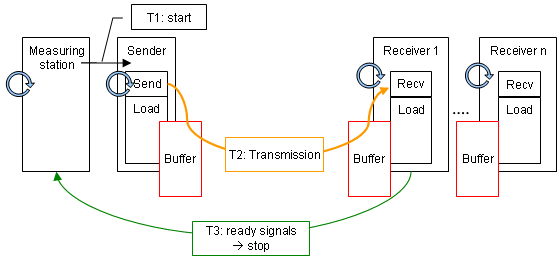
The transmission time specifies how long it takes to send a data package from the user area (data block) of the sending station, to the user area (data block) of the receiving station.
The transmission time is measured in a measuring station:
The ready signal (I/O signal, see figure "Function model") indicates that the
transferred data are entirely located in the user area (data block).
Sending and receiving of data occurs cyclically in OB1. There is precisely one call of the communication function per cycle.
The measurement is repeated 50 times per configuration (measuring setup). This is used for determining the minimum and maximum value.
The following function model explains the measuring method:

The following table describes the intervals Tx:
| Time | Tx is the time from / to: | |
|---|---|---|
| T1 | from | Measuring triggers start signal using direct command |
| to | Start signal is recognized by sender via process alarm erfasst | |
| T2 | from | Sender triggers all send jobs |
| to | Sent data is in user data block of the receiver(s) | |
| T3 | from | Receiver sets the ready signal via direct command |
| to | All ready signals are recognized using process alarm | |
Note:
- The transmission time is equivalent to T2.
- Using direct commands as well as the process alarms minimizes the systematic error caused by the signal runtime
of the start/ready signals (T1+T3). Otherwise, the cycle times would be added to the signal runtime.